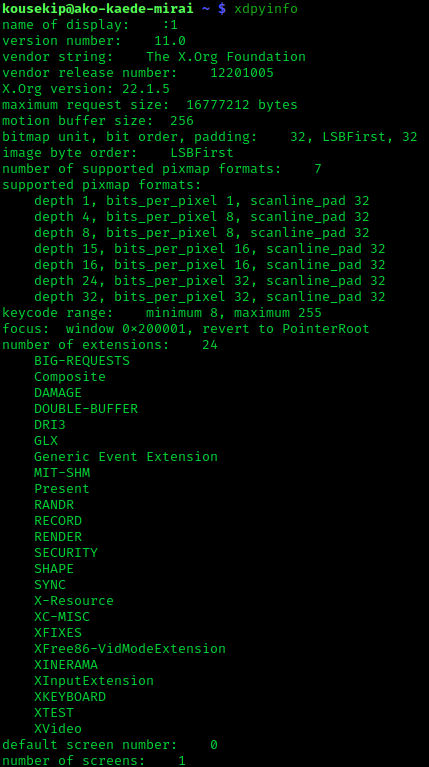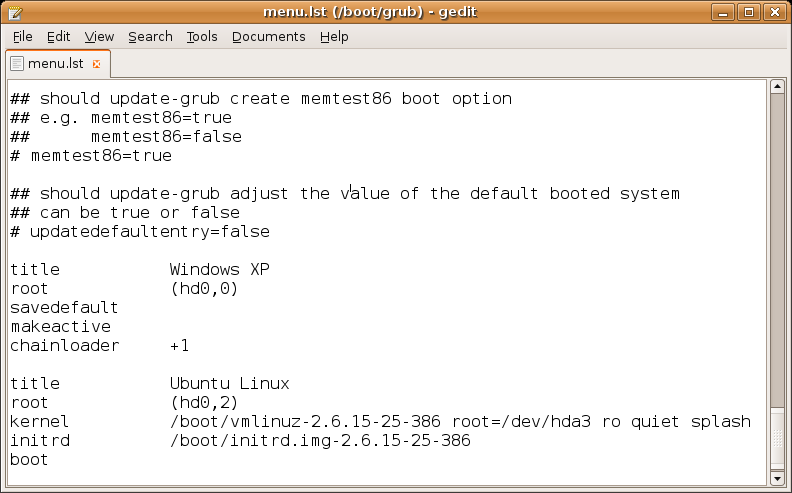|
XF86Config
The configuration file XF86Config of the XFree86 project is used by the X server to set necessary configuration parameters. It is a plain text file ordered into sections and subsections. Important sections are ''Files'', ''InputDevice'', ''Monitor'', ''Modes'', ''Screen'', ''Device'', and ''ServerLayout''. Sections can appear in any order and there may be more than one section of each kind, for example, if you have more than one monitor, say a video projector and an onboard LCD of a notebook. The ''Monitor'' sections are for the physical displaying devices, the ''Screen'' sections are for the logical displays, so you can have two monitors displaying the same content or entirely different information. The option "SWCursor" in the Device section for example controls whether the mouse pointer is mirrored on an external monitor or suppressed. On typical Unix-like systems the file often is found in /etc/X11 and a log file is in /var/log, typically named XFree86.0.log for the last st ... [...More Info...] [...Related Items...] OR: [Wikipedia] [Google] [Baidu] |
XFree86
XFree86 is an implementation of the X Window System. It was originally written for Unix-like operating systems on IBM PC compatibles and was available for many other operating systems and platforms. It is free and open source software under the XFree86 License version 1.1. It was developed by the XFree86 Project, Inc. The lead developer was David Dawes. The last released version was 4.8.0, released December 2008. The last XFree86 CVS commit was made on May 18, 2009; the project was confirmed dormant in December 2011. For most of the 1990s and early 2000s, the project was the source of most innovation in X and was the ''de facto'' steward of X development. Until early 2004, it was almost universal on Linux and the BSDs. In February 2004, with version 4.4.0, The XFree86 Project began distributing new code with a copyright license that the Free Software Foundation considered GPL incompatible. Most open source operating systems using XFree86 found this unacceptable and moved to a f ... [...More Info...] [...Related Items...] OR: [Wikipedia] [Google] [Baidu] |
Xorg
X.Org Server is the free and open-source implementation of the X Window System display server stewarded by the X.Org Foundation. Implementations of the client-side X Window System protocol exist in the form of ''X11 libraries'', which serve as helpful APIs for communicating with the X server. Two such major X libraries exist for X11. The first of these libraries was Xlib, the original C language X11 API, but another C language X library, XCB, was created later in 2001. Other smaller X libraries exist, both as interfaces for Xlib and XCB in other languages, and as smaller standalone X libraries. The services with which the X.Org Foundation supports X Server include the packaging of the releases; certification (for a fee); evaluation of improvements to the code; developing the web site, and handling the distribution of monetary donations. The releases are coded, documented, and packaged by global developers. Software architecture The X.Org Server implements the server side of ... [...More Info...] [...Related Items...] OR: [Wikipedia] [Google] [Baidu] |
XFree86 Modeline
: ''A mode line may also refer to a line for the Emacs and Vim editors that provides information about the file and modes.'' A modeline is a configuration line in xorg.conf or the XFree86 configuration file (XF86Config) that provides information to the display server about a connected computer monitor or television and how to drive it at a specified display resolution. The Modeline is based on the Generalized Timing Formula or the Coordinated Video Timings standards produced by VESA. Modelines are now rarely used, but XFree86 and the Xorg Server still allow them to be set should the EDID information be inadequate. Syntax Each modeline has ten parameters, beginning with a label for the resolution being specified. The second parameter specifies the rate of the pixel clock in megahertz. Then follow four numbers that together specify the ''x''-resolution (width) and related parameters, and four numbers that specify the ''y''-resolution (height). * Modeline syntax: * Flags (optio ... [...More Info...] [...Related Items...] OR: [Wikipedia] [Google] [Baidu] |
Configuration File
In computing, configuration files (commonly known simply as config files) are computer file, files used to configure the Parameter (computer programming), parameters and Initialization (programming), initial settings for some computer programs. They are used for user application software, applications, Server (computing), server processes and operating system settings. Some applications provide tools to create, modify, and verify the syntax of their configuration files; these sometimes have graphical interfaces. For other programs, system administrators may be expected to create and modify files by hand using a text editor, which is possible because many are human-editable plain text files. For server processes and operating-system settings, there is often no standard tool, but operating systems may provide their own graphical interfaces such as YaST or debconf. Some computer programs only read their configuration files at Booting, startup. Others periodically check the configur ... [...More Info...] [...Related Items...] OR: [Wikipedia] [Google] [Baidu] |
O'Reilly & Associates
O'Reilly Media (formerly O'Reilly & Associates) is an American learning company established by Tim O'Reilly that publishes books, produces tech conferences, and provides an online learning platform. Its distinctive brand features a woodcut of an animal on many of its book covers. Company Early days The company began in 1978 as a private consulting firm doing technical writing, based in the Cambridge, Massachusetts area. In 1984, it began to retain publishing rights on manuals created for Unix vendors. A few 70-page "Nutshell Handbooks" were well-received, but the focus remained on the consulting business until 1988. After a conference displaying O'Reilly's preliminary Xlib manuals attracted significant attention, the company began increasing production of manuals and books. The original cover art consisted of animal designs developed by Edie Freedman because she thought that Unix program names sounded like "weird animals". Global Network Navigator In 1993 O'Reilly Media creat ... [...More Info...] [...Related Items...] OR: [Wikipedia] [Google] [Baidu] |
Sebastopol, California
Sebastopol ( ) is a city in Sonoma County, in California with a recorded population of 7,521, per the 2020 U.S. Census. Sebastopol was once primarily a plum and apple-growing region. Today, wine grapes are the predominant agriculture crop, and nearly all lands once used for orchards are now vineyards. The creation of The Barlow, a $23.5 million strip mall on a floodplain at the edge of town, converting old agriculture warehouses into a trendy marketplace for fine dining, tasting rooms, and art, has made Sebastopol a popular Wine Country destination. Famous horticulturist Luther Burbank had gardens in this region. The city hosts an annual Apple Blossom Festival in April and is home to the Sebastopol Documentary Film Festival. History The area's first known inhabitants were the native Coast Miwok and Pomo peoples. The town currently sits atop multiple village sites. The town of Sebastopol formed in the 1850s with a U.S. Post Office and as a small trade center for the farmers o ... [...More Info...] [...Related Items...] OR: [Wikipedia] [Google] [Baidu] |
Unix
Unix (; trademarked as UNIX) is a family of multitasking, multiuser computer operating systems that derive from the original AT&T Unix, whose development started in 1969 at the Bell Labs research center by Ken Thompson, Dennis Ritchie, and others. Initially intended for use inside the Bell System, AT&T licensed Unix to outside parties in the late 1970s, leading to a variety of both academic and commercial Unix variants from vendors including University of California, Berkeley (Berkeley Software Distribution, BSD), Microsoft (Xenix), Sun Microsystems (SunOS/Solaris (operating system), Solaris), Hewlett-Packard, HP/Hewlett Packard Enterprise, HPE (HP-UX), and IBM (IBM AIX, AIX). In the early 1990s, AT&T sold its rights in Unix to Novell, which then sold the UNIX trademark to The Open Group, an industry consortium founded in 1996. The Open Group allows the use of the mark for certified operating systems that comply with the Single UNIX Specification (SUS). Unix systems are chara ... [...More Info...] [...Related Items...] OR: [Wikipedia] [Google] [Baidu] |
Cathode Ray Tube
A cathode-ray tube (CRT) is a vacuum tube containing one or more electron guns, which emit electron beams that are manipulated to display images on a phosphorescent screen. The images may represent electrical waveforms ( oscilloscope), pictures (television set, computer monitor), radar targets, or other phenomena. A CRT on a television set is commonly called a picture tube. CRTs have also been used as memory devices, in which case the screen is not intended to be visible to an observer. The term ''cathode ray'' was used to describe electron beams when they were first discovered, before it was understood that what was emitted from the cathode was a beam of electrons. In CRT television sets and computer monitors, the entire front area of the tube is scanned repeatedly and systematically in a fixed pattern called a raster. In color devices, an image is produced by controlling the intensity of each of three electron beams, one for each additive primary color (red, green, and bl ... [...More Info...] [...Related Items...] OR: [Wikipedia] [Google] [Baidu] |


.jpg)
